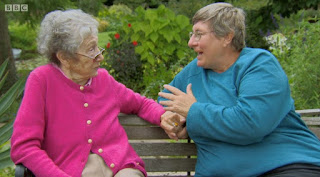
Christine Walkden introduces us to Glorious Gardens from Above Episode 2 Essex.
She tells us that Great Britain has some of the best gardens in the world and this programme is about the wonderful plants and the wonderful people that tend to them.
Christine has found another way to enjoy a garden and that is from above!
She says you get to see a garden in a whole different light, how it sits in the landscape, the effects of the climate and she also loves ballooning.

Today she is visiting a South eastern County with a lovely rural landscape and waterways which ends with 350 miles of Coastland with the Thames going straight into London and this is Essex.
To the North there is Epping Forest, to the South the Thames Estuary, to the East marshlands and mudflats.
The climate is temperate due to the maritime geography and it is also one of the driest in the Country so there are some interesting Gardens to visit.
The Gardens are 5 miles east of Colchester and they are a favourite of Essex resident Christine.
They were started in 1960 and are world renowned for their natural approach to planting and includes a lake, woodlands and the Dry Garden which is unique.

The Gardens are the vision of Beth Chatto and her Farmer Husband Andrew (Andrew sadly died in 1999 and Beth sadly died in 2018) who started the garden on a patch of wilderness.
Beth philosophy is right plant right place, to grow plants in conditions they would be in their native habitat.
The wilderness is now a wonderful garden.
The most famous part of the garden is the Gravel Garden which is full of fantastic plants all suited to drought conditions and it has never been watered artificially.
There is also a Water Garden full of Irises and Water Lillies which consists of 4 ponds all surrounded by planting.
There is also a Woodlands Garden full of shade loving plants.
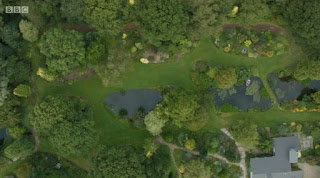
Beth Chatto was not Horticulturally trained but has a good idea of what works and she also loves to experiment, which Christine loves.
When it all started back in 1960 she moved to a new house with Husband Andrew who was a Farmer and the soil conditions around the house were gravelly soil and a boggy ditch!
Still they planned a garden and the difficult areas would become features in the garden.

In 1981 a young reporter called Alan Titchmarsh visited them to see the garden they had made out of the problem areas and to talk about the weed problem and soil problems they had faced.
The garden flourished as they worked with the areas and planted the right plant in the right growing conditions as Andrew carefully researched every plant and collected them from all over the World.

Beth tells Alan the shape of the plant and foliage is important to her and she likes the shapes to contrast.
When Alan visited Beth was already a TV personality and Gardening Author as well as a Gold Medal winner every year at The Chelsea Flower Show and the gardens were open to the public.
When this was shown in 2014 Beth was 91 years old (she was 94 years old when she sadly died) and not so hands on in the garden and the Garden Director is David Ward.

Christine meets with David who is busy collecting Phlomis Russeliana seeds which is also known as Turkish Sage and its yellow flowers have faded to seed heads.
The seed heads rattle when they are ready and they use a bag with the plants name written on to collect the seeds which will be stored until next year where they will be re-sowed or sold.
Christine Asks David how he came to the Garden and he has been there over 30 years and originally turned down working there before seeing his error.

When he first started Beth ran the garden and was very involved and had her own way of doing things including taking cuttings with a razor blade and plasters at the ready. David did not approve of this!
The Garden is a lot of work and can see all the work Beth has put in and is proud to carry the garden on for her.
David seen changes and helped Beth do her more radical schemes including the Gravel Garden which was created out of a Car Park in 1992.

It started as an experiment to see what drought-resistant plants and sun-loving plants would survive with no irrigation.
There was a hot spell in the first 2 years and plants were drooping. Beth wanted to water and save them but David insisted they left them and the Gravel Garden flourished from then.
Inside the seed bag Christine has noticed they have also shaken off insects including Sheild bugs. Earwigs and Ladybirds and Davis says they leave the bag open so they can crawl off.
They head off to sort the seeds and have a cuppa.
Beth Chatto planting theory is Japanese based about the 3 layers of Heaven, Earth and Man and in her garden if you look up or down there something beautiful at every level.
The garden full of triangulation and the planting beds have lovely lines of shape and form whatever way you view it from.
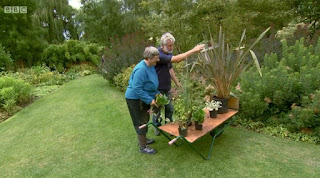
Christine shows us how you can also do it in pots and you need to contrast leaf shapes and sizes and not just plant in lines.
You need to play about with the pots to create the effect before planting them and Christine says she loves playing with plants at the Garden Centre.
Sedum
For dry soil Sedums are very nearly a perfect plant as they are low maintenance and drought resistant, they flower in the Summer and still look good in the Winter.
The smaller Sedums are good for ground cover and taller ones for cutting and drying and they are also good for wildlife by attracting Bees and Butterflies.
Beth not only was busy creating the garden but also had a family to look after with 2 daughters and 6 Grandchildren and their children have all grown up in the garden as their playground.
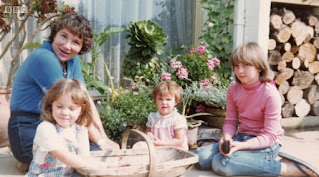
Julia Bolton is Beth's eldest Granddaughter and is the Commercial Director at the Garden and Christine asks her about her memories growing up in the Garden.
Julia says she has memories in parts that no longer exist so they used to play football in the car park that was to become the Gravel Garden.
Her favourite place is the Water Garden and her and her brothers spent every school holiday here when Beth was at the height of her career.
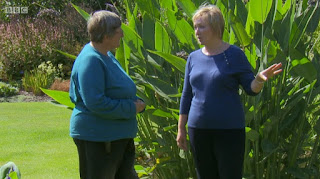
Just as she had it as a playground now her children do and Julie says they used to race boats and asks Christine if she wants to join in.
No pushing in the water as Julie used to do to her brother was decided upon as they start the race.
Christine has gone completely the wrong way and sails off into the sunset!
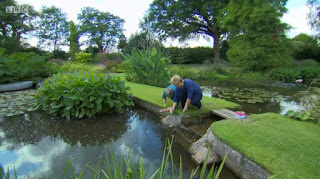
Julie is so proud of the Garden and everything her Grandmother has done although they both still have plans for the future.
Gardens change all the time but it will always be planted in Beth's style and they are excited to set up an Educational Charity in Beth Chatto's name.
They head off to race some more paper boats.
Thames Barges

A few miles away is the River Colne which had a trade route in its tricky waters and from above you get an amazing view of the Essex coastline.
in the 19th Century the estuaries as they went into the North Sea would have been crowded with the Thames Barges with their cargoes of grain, brick and coal.
Kitty, a Thames Barge dates back to 1895 and has been restored to still work and Kevin Burtonshaw is her current Skipper.
The Thames Barges all have flat bottoms so they could get up inlets to deliver to the villages things like coal and goods from London etc.
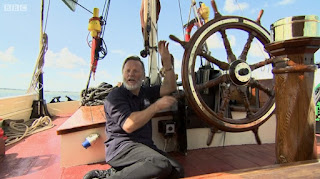
They would also take Haystacks to London then take the manure back for the fields.
There used to be over 2,000 Thames Barges and Kitty even played a part in World War 1 taking ammunitions to France.
The end came in the 40's and 50's when no one wanted to work on the Barges so they went out of fashion except for a few that have now been restored.
50 miles south toward London lies another magnificent garden Hyde Hall, which sits up on a hill surrounded by countryside.
It used to be a farm and it was very exposed to the elements and now a Garden it is a mix of Historic and Contemporary Horticulture that has Woodlands, Meadows and Hedgerows, a Dry and New World Garden.
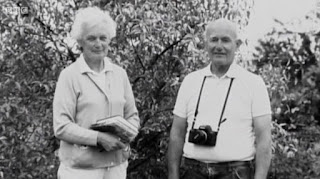
Dick and Helen Robinson bought the Farm in 1955 there was a few trees and overgrown fields of Rye Grass and a derelict Orchard.
They started by clearing the land.

The Garden Curator is Ian Le Gros and Christine used to teach him as they greet each other with a hug and kiss.
He is busy adding some more rock and plants to a border and Christine volunteers to help dig.
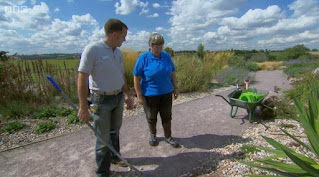
Christine says he was her Student last time they met and he still has fond memories of it and how she used to shout at them if they were not concentrating.
Ian is now in charge of the whole site and all the activities that happen and Christine says she likes seeing his name in the press and she proud thinking he was one of her students.
There has been lots of changes over the last 22 years as the site was also a wilderness like at Beth Chatto's Garden but the soil here is heavy clay making for several challenges.
Ian says they spend more money under the ground than on top at Hyde Hall.
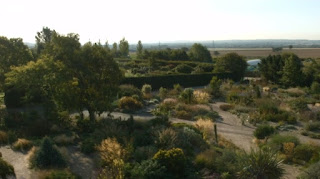
They are moving a large rock into place in the Dry Garden and they have prepared the soil by mixing sharp sand and grit to dry out the clay soil.
It is now perfect growing conditions for drought-resistant plants.
Lavender
Lavender is a Mediterranean plant with more than 30 types, which likes to be in full sun in a well drained soil.
It comes in a range of colours on the blue to violet scale and has a very distinctive scent.
Lavender is reputed as being good for relaxation and a sleep aid.

Ian favourite part of the garden is on the Hilltop which is the 6 formal beds filled with flowers in the Rose Garden.
He likes it for the formal look of the garden and for the Old English Flower Roses and their scent.
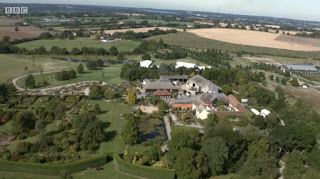
The plans for the future are to improve the Perennial Meadows and the hay meadows with huge drifts of bulbs and trees and beyond that is the Wildwood they been planting over the last 5 years.
Christine says that's why she likes it here as they are always improving the site as well as showing people what is possible on an exposed and dry site.
Salt Marshes

A few miles from Hyde Hall is the Salt Marshes that have looked the same since prehistoric times.
They form a unique habitat for plant life that actually can survive on these growing conditions.
Neil Harvey from the Essex Wildlife Trust says they have been here since the last Ice Age and were created by silt moving down to the coast that run out of energy and is left behind and it is very high in nutrients.
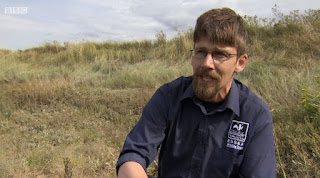
The vegetation is specialised with very few species of plants that can cope with the conditions.
The Salt Marshes are covered by the salty tide twice a day and the plants are all salt-tolerant like Samphire, which is a succulent and Sea Lavendar.
As well as plants the Blackwater Estuary has been fished for its Oysters right up to the present day and sheep and their lambs are also grazed on the land.
But the most farmed thing from this landscape is the salt itself.
Maldon is an Ancient Town at the head of the Salt Marshes and has been in the Salt industry for thousands of years.

Clive Osborne's family have been doing it for 4 generations and it was even in the Domesday book about the Salt production.
The Maldon Crystal Salt Company, the original company is famous for its salt and the process of obtaining the salt has not changed much since.
Sea water is filtered and boiled until the salt is left.
Wivenhoe
Wivenhoe is a transition town that practices sustainability and the saving of our natural resources like oil but using local shops and produce.
Ruth Melville says they have been doing this since 2008 and they are using unused land to grown their own produce.

One of the sites is the old Station Masters Garden at the Railway Station which is now a Herb and Vegetable plot.
When they had a glut of Marrows they made Marrow Curry which they gave to the Commuters using the Station.
Local business have also joined in and in a pub back garden there is a Community Chicken Coop and Carole Rennie and Son Joshua help look after.
It is shared between 8 people and they all take turns to let the chickens out, clean them out, collect the eggs and feed them scraps.

They took over a plot from the Council and made a Wildlife Garden which John Rowland looks after and it was just shrubland before.
Once it was cleared they added a pond and they do activities like pond dipping and today they are having an outdoor meal.
Christine heads Back to Beth Chatto's Garden to gift something to the gardens that she loves.
After seeing the bugs in the seeds she decided that a Bee Hive would be the perfect thing and also to attract Wildlife.
Plants need to be pollinated to reproduce and not only Bees do it there also Bats, Birds and Insects that do.
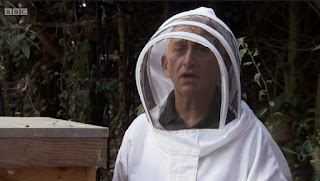
Essex Beekeeper Lee Bartrip started his interest after having a swarm of Bees in his garden, this lead on to him joining his local Bee Association.
He installed a Bee Hive and became a Bee Keeper with a colony of 15,000 Bees.
A worker Bee visits around 100 flowers on every trip out of the Hive.
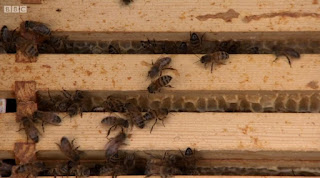
The young Bees process the sugary substance in the comb cells in the hive and then water is added until it thickens into Honey.
To produce 1 pound of Honey, 500 Bees visit over 2 million Flowers.
Gardens provide an ideal habitat for Bees especially one like Beth Chatto's that is in harmony with the natural world.
Beth no longer appears on the Television but has agreed to meet with Christine.
Christine greets Beth and tells her what a privilege it is to meet with her and tells her the Garden is a testament to her and Andrew.

How Andrew collected all the plants and brought them back to Beth to put in the right place in the garden and Beth agrees they were a good partnership.
Beth said they were so different, Andrew was not a practical gardener and Beth was very young when she met him and was keen on gardening as her parents had been.
Andrew idea of using Native plants brought from their home countries and not Hybrids and to keep them as they grow in the wild.
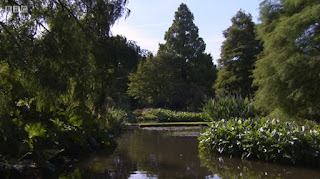
The Garden still uses the Japanese golden rule of the Earth, Heaven , Man line.
Christine thanks her for the special garden she is leaving for everyone and they hug, as Beth says she is overwhelmed.
Beth has always inspired Christine and nothing she can give her could reward her for a lifetime of gardening achievements, but she can give her something to benefit the garden.
To round off her day in Essex she has gathered everyone in the Garden for tea and Honey Cake, Christine soon tucks in.
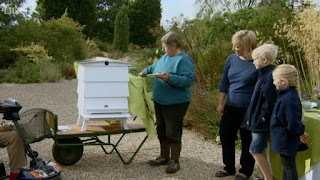
She says what a lovely garden and how lovely Beth is and her family and great grandchildren and David is also there to see her present the Beehive to them.
Beth loves the fact it is an old fashioned one too, as they eat more cake and laughter fills the garden.
All Photographs are copyright of BBC.com
Previous Episode 🎈 Next Episode


No comments:
Post a Comment